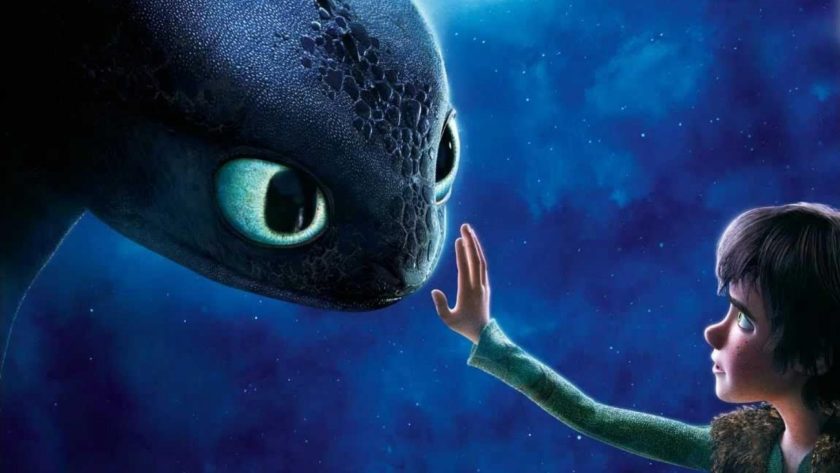Mayra Nassef reflects on the first film of the popular ‘How to Train Your Dragon‘ franchise, and how (over 10 years since its release) it can still teach us a thing or two about what it means to ‘be a man’.
How to Train Your Dragon (2010) is a timeless classic. It’s a film I’ve watched countless times as a child and a movie I continue to watch several times a year. You could say that the first film in the franchise is my Roman Empire (I hope this joke remains relevant by the time you have come across this article, dear reader). The score still sends chills down my spine – undoubtedly due to John Powell’s incredible compositions. However, like any expertly made film, a rewatch adds many different layers that you completely missed before. I realised that there were layers that were staring me right in the face – a stark revelation: HTTYD’s message about toxic masculinity and stereotypes in general. Big time!
If you haven’t seen the film in a while, here’s a little refresher – although I would highly recommend you (re)watch the film. The vague Viking town of Berk is frequented by dragons who consistently seem to pose a threat. The townspeople learn how to capture and fight these dragons. However, Hiccup (our protagonist) is not quite the fighter he is expected to be, unluckily for him, he’s the son of the chief (Stoick); a man very much determined to decimate the population of dragons.
To impress his father and his town – his love interest Astrid too – Hiccup attempts to hunt down the uncatchable, highly sought after ‘Night Fury’. Following these events, Stoick admits Hiccup to a dragon-fight course, but an excursion to the woods changes everything, as he runs into the downed Night Fury who is now unable to fly. Despite Hiccup having a clear opportunity to kill the dragon, he could not bring himself to. The two form an unlikely friendship, and Hiccup names him Toothless (*awws ensue*). To summarise, Hiccup then learns about the world of dragons, becomes great at dragon-fighting whilst using highly pacifist methods. By the end, he convinces the town that dragons can actually be peaceful, and that their actions have been a misunderstanding as there are larger, evil forces at play.
The film is quite eager to poke fun at the rigidity of stereotypes, so clearly exemplified by the comically archetypal names. Stoick is the perfect archetype for traditional masculinity – stoicism. Hiccup reflects the character’s bumbling fish-out-of-water archetype, while Astrid’s name means “extremely pretty” in Scandinavian. All these characters come to represent more than just their archetypes by the end of the film, but their names are the first starting point for the film’s subversion of these rigid archetypes. Stoick becomes a more open-minded ruler, Hiccup becomes a hero, and Astrid becomes more than just a love interest.
From the get-go, it is clear Hiccup’s strength is not in his build – his lanky figure is constantly contrasted with the rest of the characters’ figures. Mechanics seem to interest him more than the battlefield and, while other characters use physicality and violence as a measure of their strength; it is clear that this is a result of the hegemonic tradition of masculinity. Hiccup’s eagerness to understand and find solutions with others to issues is what makes him a great leader in the later films, not his physical strength. Funnily enough, in the film he seems to excel at designing mechanical solutions rather than weapons. He uses this skill to build a mechanical tail for Toothless so that he is able to fly again.
In both dragon-based and daily life, physical abilities and battle scars are worn as a badge of honour and a testimony to masculinity. Due to this, Hiccup sees his inability to kill Toothless – or any dragon for that matter – as a weakness. Yet over the course of the film it is this same empathy and compassion that forms his strength. He could not kill Toothless because he looked as “frightened” as he was: “I looked at him and saw myself”.
By the end, Hiccup clearly champions an alternative version of masculinity, except he swaps battle scars for a prosthetic leg behind which is a story of empathetic sacrifice rather than thoughtless violence – a lovely subversion that nicely wraps up the film’s message. This alternative angle, also speaks to how the film handles the theme of disability in a really great way – something worth an entire piece in itself. It is not the physicality that represents someone’s strength. It’s empathy and understanding. Empathy is essential in times of conflict, it is what breeds cooperation and compassion.
HTTYD continues to subvert the masculine stereotype in the female character of Astrid – one of my favourites from animation – who seems to embody the traditional masculine stereotype better than the protagonist himself. Her character is one that many women in male-dominated industries or workplaces often embody or know too well. Her character development shows her embracing her true self rather than what she feels she has to perform to be taken seriously by the other characters. When Hiccup advances quite swiftly in training, her anger is contextual and does not need to be explained. As a girl, she often has to work harder than all the others and fit into traditionally masculine stereotypes. Therefore, when Hiccup uses alternative pacifist methods and gains the admiration and success she has yearned for, it angers her because of the metaphorical glass ceiling. Throughout the film, she learns to embrace her empathetic and protective side – going on a personal journey of her own, which reminds me of Colette’s own journey from Ratatouille – another animated masterpiece.The deconstruction of masculinity and stereotypes is two-fold in HTTYD. It is experienced by all the characters, and exemplified by the dragons themselves. The dragons are previously seen as dangerous and violent – a xenophobic assumption. It is only through understanding and learning more about the unknown can we really move forward together; that is the core message. It’s a warning against stereotypes, and a reclamation of empathy as a strength. This is what makes How To Train Your Dragon so potent almost 13 years later. It’s a movie that feels timeless because the themes within resonate so strongly with people of all ages at all times. It’s also proof that animated films made for children do not need to be diluted and aimless, in fact they can have just as much depth as a (good) live-action film.




